The Traumatic Brain Injuries Treatment Market is estimated to be valued at USD 2.1 billion in 2025 and is projected to reach USD 4.3 billion by 2035, registering a compound annual growth rate (CAGR) of 7.4% over the forecast period.
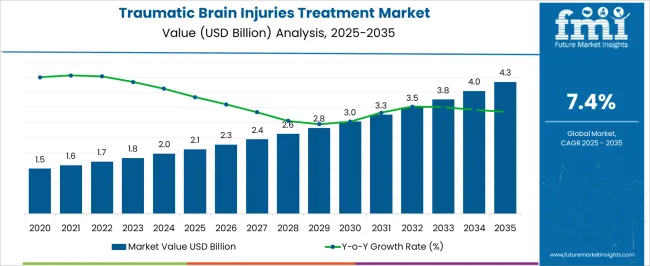
| Metric | Value |
|---|---|
| Traumatic Brain Injuries Treatment Market Estimated Value in (2025 E) | USD 2.1 billion |
| Traumatic Brain Injuries Treatment Market Forecast Value in (2035 F) | USD 4.3 billion |
| Forecast CAGR (2025 to 2035) | 7.4% |
The Traumatic Brain Injuries Treatment market is witnessing steady growth, driven by the increasing prevalence of head injuries resulting from road accidents, falls, and sports-related incidents. The rising demand for effective treatment options is being supported by advances in neuropharmacology, improved diagnostic tools, and enhanced patient monitoring systems. Growth is further reinforced by increased awareness among healthcare providers and patients about the long-term impact of traumatic brain injuries and the importance of early intervention.
Ongoing research and clinical trials focusing on neuroprotective agents, cognitive function recovery, and rehabilitation therapies are contributing to the development of innovative treatment solutions. Hospitals and specialty clinics are adopting structured treatment protocols to optimize patient outcomes. Regulatory emphasis on safety, efficacy, and patient adherence is shaping the market landscape.
As healthcare systems worldwide invest in infrastructure, neurological care units, and specialized medical training, the market for traumatic brain injury treatments is expected to expand Increasing collaborations between pharmaceutical companies, research institutes, and healthcare providers are also accelerating product availability and adoption, positioning the market for long-term growth.
The traumatic brain injuries treatment market is segmented by treatment type, route of administration, distribution channel, and geographic regions. By treatment type, traumatic brain injuries treatment market is divided into Drugs, Analgesics, Anti-Anxiety Agents, Anti-Coagulants, Anti-Convulsants, Anti-Depressants, Anti-Psychotics, Others, and Surgery. In terms of route of administration, traumatic brain injuries treatment market is classified into Oral and Injectable. Based on distribution channel, traumatic brain injuries treatment market is segmented into Hospital Pharmacies, Drug Stores, and Independent Pharmacies. Regionally, the traumatic brain injuries treatment industry is classified into North America, Latin America, Western Europe, Eastern Europe, Balkan & Baltic Countries, Russia & Belarus, Central Asia, East Asia, South Asia & Pacific, and the Middle East & Africa.
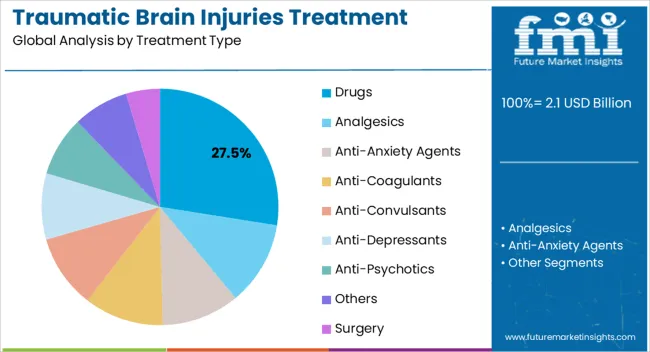
The drugs segment is projected to hold 27.5% of the market revenue in 2025, establishing it as the leading treatment type. Growth in this segment is being driven by the availability of neuroprotective agents, anti-inflammatory drugs, and cognitive enhancers that address the complex pathophysiology of traumatic brain injuries. These drugs are critical for managing secondary brain damage, reducing complications, and improving patient recovery outcomes.
Advancements in formulation, dosage optimization, and targeted delivery methods have improved therapeutic efficacy. Hospitals and clinics are increasingly adopting pharmacological protocols as part of integrated care strategies to enhance patient prognosis. The segment is further strengthened by ongoing clinical research, regulatory approvals, and the introduction of innovative compounds designed to support neurological recovery.
Cost-effectiveness, safety, and accessibility of drugs are key factors driving adoption among healthcare providers As awareness of evidence-based treatment options grows and research continues to identify novel drug candidates, the drugs segment is expected to maintain its market leadership in traumatic brain injury management.
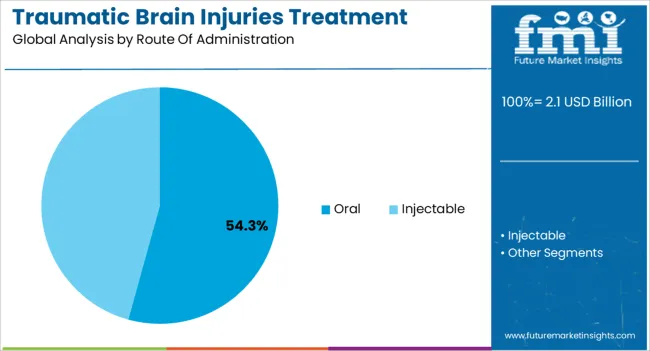
The oral route of administration segment is expected to account for 54.3% of the market revenue in 2025, making it the leading route of delivery. This dominance is being driven by the convenience, patient compliance, and ease of dosing associated with oral formulations. Oral administration allows for flexible treatment schedules and can be adapted for both acute and long-term management of traumatic brain injuries.
Pharmaceutical advancements have improved bioavailability and absorption of neuroactive agents, enhancing clinical outcomes. Hospitals and outpatient care centers favor oral administration for its practicality and reduced need for invasive procedures. Cost efficiency, patient comfort, and the ability to combine multiple therapeutic agents into single oral regimens further support growth.
As awareness about adherence to prescribed therapy increases among patients and caregivers, the oral segment continues to dominate Regulatory approvals, clinical guideline recommendations, and widespread adoption across healthcare settings reinforce the oral route as the preferred delivery method for managing traumatic brain injuries.
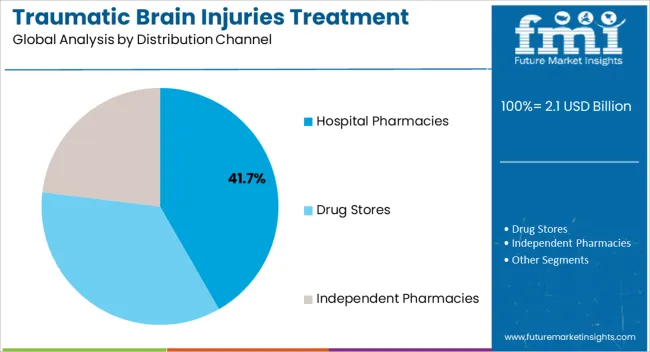
The hospital pharmacies distribution channel is projected to hold 41.7% of the market revenue in 2025, establishing it as the leading distribution route. Growth is being driven by the central role hospitals play in managing acute traumatic brain injury cases and providing specialized care. Hospital pharmacies offer controlled dispensing, adherence monitoring, and access to a wide range of approved medications tailored for neurological recovery.
The presence of multidisciplinary teams ensures proper dosing, administration, and patient counseling, which enhances therapeutic outcomes. Integration with hospital supply chain management systems ensures timely availability and efficient inventory management. The adoption of electronic health records and pharmacy management systems further strengthens distribution efficiency.
Regulatory compliance, quality assurance, and standardized protocols make hospital pharmacies a trusted channel for healthcare providers and patients As hospital infrastructure expands and investment in neurological care increases, this channel is expected to maintain its leadership in delivering effective treatments for traumatic brain injuries.
Each year traumatic brain injuries (TBI) contribute a substantial number of cases worldwide. TBI can be defined as an injury to the brain resulting from externally inflicted trauma resulting in damage to the brain cells and blood vessels. The signs and symptoms of TBI may appear soon after the head trauma or may sometimes take several days to weeks to appear.
TBI can be categorized as mild, moderate and severe brain injury. In case of a mild injury a patient experiences a brief concussion and in rare situations may lead to lasting functional brain changes. However, the risk of developing severe and permanent brain damage increases with the extent and severity of the traumatic brain injury and the level of unconsciousness.
Depending up on the location of the injury, TBI can lead to dementia along with memory, lack of concentration, problems related with speech and eating, lack of coordination and walking problems are often associated with moderate to severe brain injuries. As estimated by Center for Diseases Control and Prevention (CDC) every day 138 people in the USA die from TBI.
According to the CDC 2010 estimates in the USA approximately 2.5 million emergency department visits and hospitalization were associated with TBI cases (either alone or in combination with other injuries). Falls are leading cause of hospitalization in patients with TBI followed by accidents including motor, vehicle traffic injuries.
Mild traumatic brain injuries do not require treatment other than over the counter pain relievers and the patient with mild traumatic injury need not to be monitored in hospital. However for treatment of severe TBI several medications indicated includes several diuretics, anti- seizure drugs, comma inducing drugs etc.
However, in case of severe TBI surgery and rehabilitation is required. The traumatic brain injuries treatment market is expected to witness higher growth over the forecast period owing to introduction of several new therapies. Increasing number of manufacturers are developing new medications for the treatment of TBI and large number of clinical trials are conducted in order to better understand the etiology of the condition.
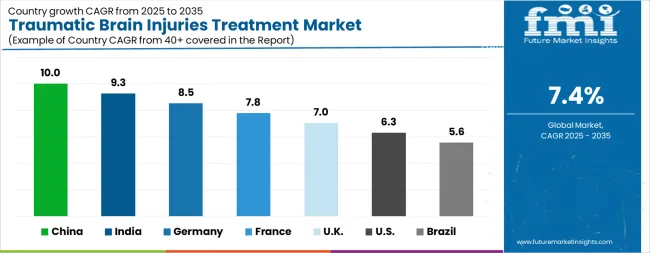
| Country | CAGR |
|---|---|
| China | 10.0% |
| India | 9.3% |
| Germany | 8.5% |
| France | 7.8% |
| UK | 7.0% |
| USA | 6.3% |
| Brazil | 5.6% |
The Traumatic Brain Injuries Treatment Market is expected to register a CAGR of 7.4% during the forecast period, exhibiting varied country level momentum. China leads with the highest CAGR of 10.0%, followed by India at 9.3%. Developed markets such as Germany, France, and the UK continue to expand steadily, while the USA is likely to grow at consistent rates. Brazil posts the lowest CAGR at 5.6%, yet still underscores a broadly positive trajectory for the global Traumatic Brain Injuries Treatment Market. In 2024, Germany held a dominant revenue in the Western Europe market and is expected to grow with a CAGR of 8.5%. The USA Traumatic Brain Injuries Treatment Market is estimated to be valued at USD 805.7 million in 2025 and is anticipated to reach a valuation of USD 1.5 billion by 2035. Sales are projected to rise at a CAGR of 6.3% over the forecast period between 2025 and 2035. While Japan and South Korea markets are estimated to be valued at USD 107.5 million and USD 57.0 million respectively in 2025.
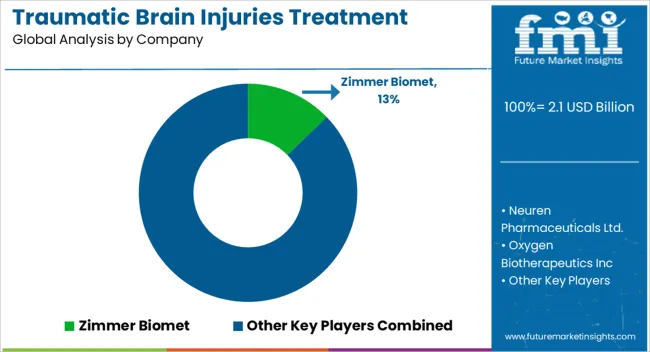
| Item | Value |
|---|---|
| Quantitative Units | USD 2.1 Billion |
| Treatment Type | Drugs, Analgesics, Anti-Anxiety Agents, Anti-Coagulants, Anti-Convulsants, Anti-Depressants, Anti-Psychotics, Others, and Surgery |
| Route Of Administration | Oral and Injectable |
| Distribution Channel | Hospital Pharmacies, Drug Stores, and Independent Pharmacies |
| Regions Covered | North America, Europe, Asia-Pacific, Latin America, Middle East & Africa |
| Country Covered | United States, Canada, Germany, France, United Kingdom, China, Japan, India, Brazil, South Africa |
| Key Companies Profiled | Zimmer Biomet, Neuren Pharmaceuticals Ltd., Oxygen Biotherapeutics Inc, Teva Pharmaceutical Industries Ltd, Ischemic, Grace Laboratories LLC, Medicortex, Amarantus BioScience Holdings, Aldagen, NeuroScience Pharmaceuticals, Targacept, BioDirection, Inc., QuesGen Systems, Inc., BrainScope Company, Inc., Neural Analytics, Inc, Oculogica, and BrainScope Company, Inc |
The global traumatic brain injuries treatment market is estimated to be valued at USD 2.1 billion in 2025.
The market size for the traumatic brain injuries treatment market is projected to reach USD 4.3 billion by 2035.
The traumatic brain injuries treatment market is expected to grow at a 7.4% CAGR between 2025 and 2035.
The key product types in traumatic brain injuries treatment market are drugs, analgesics, anti-anxiety agents, anti-coagulants, anti-convulsants, anti-depressants, anti-psychotics, others and surgery.
In terms of route of administration, oral segment to command 54.3% share in the traumatic brain injuries treatment market in 2025.






Full Research Suite comprises of:
Market outlook & trends analysis
Interviews & case studies
Strategic recommendations
Vendor profiles & capabilities analysis
5-year forecasts
8 regions and 60+ country-level data splits
Market segment data splits
12 months of continuous data updates
DELIVERED AS:
PDF EXCEL ONLINE
Post-Traumatic Stress Disorder (PTSD) Treatment Market Size and Share Forecast Outlook 2025 to 2035
Brain Fitness Market Size and Share Forecast Outlook 2025 to 2035
Brain Computing Interfaces Market Size and Share Forecast Outlook 2025 to 2035
Brain Cancer Diagnostics Market Size and Share Forecast Outlook 2025 to 2035
Brain Metastasis Therapeutics Market Analysis - Size, Share, and Forecast Outlook 2025 to 2035
Brain-Computer Interface Implant Market Analysis Size and Share Forecast Outlook 2025 to 2035
Brain Implants Market Size and Share Forecast Outlook 2025 to 2035
Brain Imaging and Neuroimaging Market Size and Share Forecast Outlook 2025 to 2035
Brain Health Supplement Market Analysis - Size, Share, and Forecast Outlook 2025 to 2035
Brain Biomarker Market Trends and Forecast 2025 to 2035
Brain Tumor Drugs Market Forecast & Analysis: 2025 to 2035
Brain Mint Market Analysis by Functionality, Consumer Orientation, Sales Channel and Region Through 2035
Brain Monitoring Systems Market is segmented by Lateral Flow Readers and Kits and Reagents from 2025 to 2035
Global Brain Monitoring Market Insights – Trends & Forecast 2024-2034
Brain Fingerprinting Technology Market
Brain Tumor Treatment Market Analysis-- Size and Share Forecast Outlook 2025 to 2035
Deep Brain Stimulator Market Trends – Innovations & Forecast 2024-2034
Kids’ Brain Health Supplements Market Size and Share Forecast Outlook 2025 to 2035
Bovine Brain Extract Size and Share Forecast Outlook 2025 to 2035
Chronic Brain Damage Treatment: Trends, Growth, and Key Developments

Thank you!
You will receive an email from our Business Development Manager. Please be sure to check your SPAM/JUNK folder too.
Chat With
MaRIA